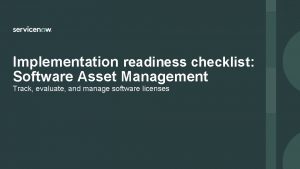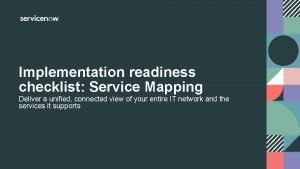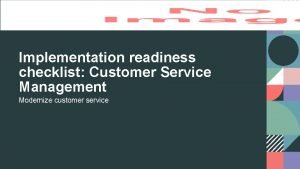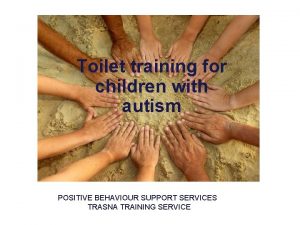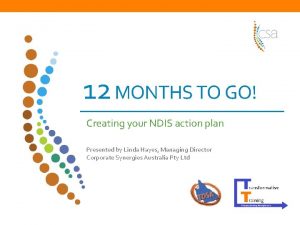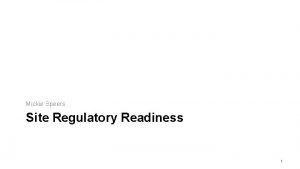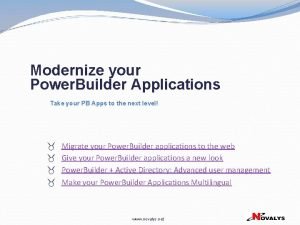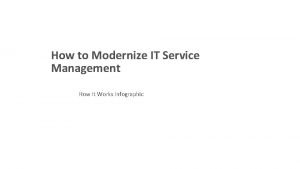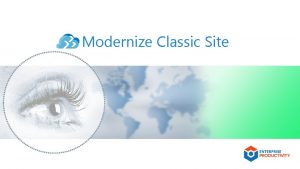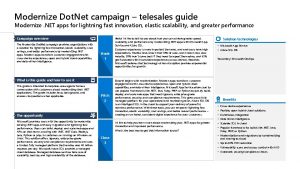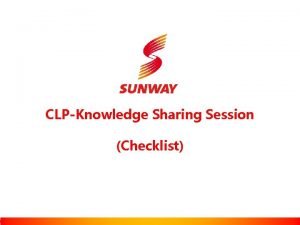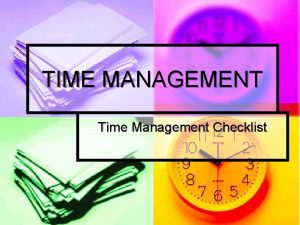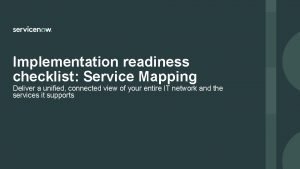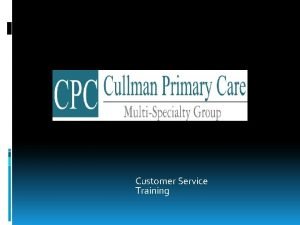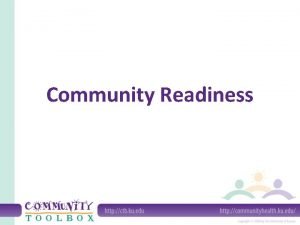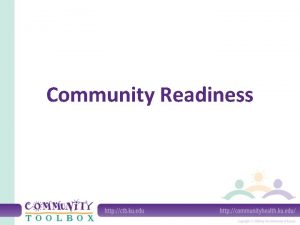Implementation readiness checklist Customer Service Management Modernize customer
















- Slides: 16

Implementation readiness checklist: Customer Service Management Modernize customer service

Customer Service Management implementation readiness checklist Introduction Service. Now® Customer Service Management elevates customer service from request to resolution. Customer Service Management allows you to identify issues earlier with event monitoring and automate processes across departments to resolve issues faster. Along with personalized self-service, this can increase customer satisfaction and enhance your operational efficiencies. The benefits of using a readiness checklist are: Ø You’ll implement and see value faster. Ø You’ll be aware of the key implementation risks and how to avoid them. Ø You’ll have a superior, more efficient design (part of the Prepare phase below) so you get the most value from your Customer Service Management implementation. The Now Create methodology described below is a proven methodology developed from thousands of Service. Now implementations. It’s the recommended approach to implementation. This checklist provides actions for the Initiate phase and for planning for the Prepare phase. It does not provide activities to execute the Prepare, Create, Transition, or Close phases* but these phases are improved and expedited by this checklist. 5. Close The implementation team hands off to the platform maintenance team. 4. Transition Gain UAT, training, go-live, and post go-live support. Now Create 3. Create Perform configuration and unit testing. 1. Initiate Define your objectives, collect prerequisite information, and define the key processes for implementation success. 2. Prepare (design for configuration) Hold workshops to understand your process and platform needs, finalize the engagement timeline, and refine your configuration requirements. *Include the activities for the Prepare, Create, Transition, and Close phases in your implementation project plan. 2 © 2020 Service. Now, Inc. All Rights Reserved.

Customer Service Management implementation readiness checklist Key risks to implementation success Common problem (risks) Impact Correction Lack of adoption leadership Poor communication; misaligned expectations; poor adoption; organizational dissent; conflicting priorities; scope creep; requirements churn; and comprised results Make sure you have a structured and active implementation leadership framework in place. Lack of organizational sponsorship Poor communication; moving expectations; missed expectation; Make sure that all affected organizations are onboarded organizational opt out; conflicting priorities; scope creep; at the start of the implementation, understand the goals, requirements churn; comprised results and share the vision. Unmanaged scope of capability Project is seen as a technology project that doesn’t require process change; capabilities are introduced without a clear link to value—sometimes for capability’s sake; conflicting priorities; scope creep; requirements churn; compromised results; long implementation timelines Develop a clear value strategy that all stakeholders adhere to and that delivers clear, measurable value incrementally. Executives and stakeholders must keep a close eye on the scope to make sure it’s balanced with the organization’s capacity to change. Over-engineered processes Processes are adopted for process’s sake or to a level of granularity that impacts usability; the trade-off between process rigor and value is not kept in balance; user opts out; compromised results Only follow processes if they demonstrate value and your organization can adopt them. When your approach allows for processes to be refined and tightened, your organization is more likely to adopt the changes and see the impact they make. 3 © 2020 Service. Now, Inc. All Rights Reserved.

Customer Service Management implementation readiness checklist Intended use The status of your Customer Service Management implementation project plan impacts how you should use this checklist: 1. If you have a scoped project plan from Service. Now Expert Services or a Service. Now certified partner – This checklist helps you align with the Service. Now best practices that will expedite readiness and enhance the design phase. Use it in addition to the recommendations provided by Service. Now Expert Services or the Service. Now certified partner who created your project plan. 2. If you don’t have an implementation project plan yet but are interested in what you need to prepare – This checklist highlights the standard steps to prepare for implementation, outlines the design phase homework, and gives you insight into some of the major decisions you’ll make during implementation design. It also supports estimating the implementation effort and timeline (with a Service. Now expert). If you’re in the process of scoping an implementation with an external services provider, use this checklist to make sure you’ve considered the best practices. 3. If you’re self-implementing – This checklist is for readiness only and doesn’t provide design, configuration, or testing activities. Work with Service. Now experts with advanced knowledge of Customer Service Management processes and technical properties, including Virtual Agent, Community, and Knowledge Management, to plan and manage your implementation. If you don’t have this expertise internally, we recommend a Service. Now certified partner or Service. Now Expert Services for planning and assistance with execution. Who should read this? The action items in this checklist are intended for the implementation owner, who can be a primary business stakeholder, project manager, or other stakeholder who manages the project management and decision-making processes on the customer side. They don’t have to be a decision-maker but are responsible for making sure decisions are made and executed. Note: If you’ve already completed some of the activities in this checklist (such as defining your business objectives), skip those activities but document them. Key readiness steps 1. Confirm the prerequisites 2. Define vision, objectives, and success 4. Create a structure for governance 3. Assess your team readiness 4 5. Plan for OCM activities 6. Plan for implementation design © 2020 Service. Now, Inc. All Rights Reserved.

Checklist: Prepare to implement Customer Service Management Step 1: Confirm the prerequisites Step 5: Plan for OCM activities See slides 6– 7 to complete this step. � Review Customer Service Management features and functionality. � Consider what capabilities you need to ensure value from Customer Service Management. � Learn about Service. Now security options. � Gather your regulatory and compliance requirements. See slide 11 to complete this step. � Build an OCM plan. � Plan for a pilot. Step 6: Plan for implementation design See slide 12 to complete this step. � Document your customer service processes and capabilities. � Determine your integration needs. Step 2: Define your vision, objectives, and success See slide 8 to complete this step. � Define your vision, business objectives, and measures of success. � Agree on the scope of your Customer Service Management implementation. Step 3: Assess your team’s readiness See slide 9 to complete this step. � Identify and prepare your implementation and maintenance resources. � Identify Customer Service Management training requirements. Step 4: Create a structure for governance See slide 10 to complete this step. � Create an implementation governance committee. � Establish a technical governance subcommittee. 5 © 2020 Service. Now, Inc. All Rights Reserved.

Step 1 a: Review the features and functionality Take the time to understand Customer Service Management capabilities and features and consider what other capabilities you will need to get the expected value from your implementation. Review Customer Service Management features and functionality • Read the Customer Service Management overview on the Service. Now website. Take note of the features, functionality, and benefits of Customer Service Management. Work with your Service. Now account team to learn what features and functionalities your existing licenses entitle you to and identify any additional capabilities you will need to add. • Review the Customer Service Management product docs. These resources are more technical and provide additional functionality detail. • Read the The Road To Transforming The Customer Service Experience ebook to better understand how Customer Service Management can help your organization achieve its goals. • Consider taking the Customer Service Management Fundamentals course to better understand feature configuration and administration. • Explore the Customer Service Management Community forum for direct access to experts and peers. Practitioner insight: Integration of IT Service Management with Customer Service Management enables users to create requests, incidents, problems, and change records from a customer service case and to resolve reported issues and fulfill submitted requests. Review our white paper and Quick Answer for guidance on successfully using ITSM with Customer Service Management. Confirm what capabilities you need to ensure value from Customer Service Management • Consider your use cases for Customer Service Management (if you haven’t already determined them). You don’t have to confirm all use cases until the design or Prepare phase (Now Create, see slide 2) but you should get an idea of how you want to use Customer Service Management and the capabilities you’ll want to implement. • The Customer Service Management application includes a broad range of customer service capabilities, including case management for agents and managers and support for external customers with omni-channel communication and self-service. Additional capabilities can further enhance customer service: • The Communities application provides customers and employees with online forums to share ideas, experiences, and solutions. • Field Service Management integrates with Customer Service Management to create work orders for customer service cases and add case information to work order forms. • IT Operations Management (ITOM) integrates with Customer Service Management to improve issue monitoring, including faster identification and remediation, and auto-creating cases for customers even before they are aware of the issue. • Confirm that you’re currently using the Now Platform® on the Paris release (or later) or that you’ll be on the Paris release when you begin implementation. The Paris release is required for capabilities such as playbooks, used to automate complex customer service processes, and guided decisions to path customer service agents through a structure troubleshooting process. Review the Customer Service Management release notes for a full list of new capabilities in the Paris release. Here are resources for upgrading, if needed. 6 © 2020 Service. Now, Inc. All Rights Reserved.

Step 1 b: Identify security requirements It is important to gather and understand your security and data privacy requirements before starting your implementation because of the sensitivity of customer data and varying data privacy regulatory and compliance requirements by geography. Take time to learn about how Service. Now handles security within Customer Service Management and determine what your requirements are for each geography where you’ll use Customer Service Management. Learn about security functionality within Customer Service Management Determine your industry and geographical requirements • Explore the various ways that Service. Now addresses security: • Platform access with user authentication or instance restriction • Role- and group-based security • Contextual security (ACLs) • Encryption Support Customer data security and regulatory requirements are determined by your industry and operational geography. Data privacy and protection processes need to be kept up to date with relevant laws and regulations to ensure they remain compliant. • Understand the Customer Service Management security model and differences between internal and external roles. • Industry-specific data privacy requirements Gather the following before starting your implementation: • National or regional data laws (data sovereignty) • Determine if you’ll need auditing capabilities. • Read our Cloud security FAQ to learn more about how Service. Now handles data. • Company-specific policies (make sure to capture geographical differences if they exist) If you intend on integrating Service. Now with another system, make sure to capture any security or regulatory requirements from that system as well. 7 © 2020 Service. Now, Inc. All Rights Reserved.

Step 2: Define your vision, business objectives, and measures of success Gaining support from leadership and stakeholders requires a vision, business objectives, and measures of success for Customer Service Management. Make sure your implementation creates value that’s measurable and that you take the present state into account so you have an appropriate implementation plan. This Success Checklist is critical and requires additional action items. Here are some suggested business outcomes and metrics for Customer Service Management to jump-start your progress: Practitioner insight: If you already have an implementation project plan and you skipped Step 2, be sure you complete Step 2 before you implement. Implementation success and adoption requires gaining sponsorship from key stakeholders and executives—and aligning with them on business. Make sure your project plan aligns with all outcomes from Step 2. Suggested Customer Service Management business outcomes: • Improved customer experience Define your vision, business objectives, and measures of success • Improved customer service efficiency • Define the vision, business objectives, and measures of success that support your overall company objectives. Include your executive sponsor in the process to ensure alignment to those objectives. Use our Success Checklist* to make sure your vision cascades into clear and measurable business outcomes. • Integrated customer service and service delivery Suggested Customer Service Management success metrics: • Customer experience – Net Promoter Score, first contact resolution, selfservice use, customer satisfaction score, customer portal use • Confirm that the vision, business goals, and measures of success are defined for the impact that you can make with Customer Service Management. • Customer service efficiency – Assignment times, cases resolved per month, inquiry assignment times, inquiry resolute times • Agree on implementation scope based on your vision. Bear in mind that achieving your goal may be an iterative process—not accomplished within one project. 8 © 2020 Service. Now, Inc. All Rights Reserved.

Step 3: Assess your team readiness There are multiple teams involved and specific skills required to implement and maintain Customer Service Management. Make sure you have the right teams in place or begin with a plan to engage them. Don’t finalize your resourcing and project plans until you’ve assessed your teams’ readiness. Identify and prepare your implementation and maintenance resources • Identify a project manager for implementation. This person should be experienced with leading software implementation projects and agile. Service. Now experience is highly preferred. • Confirm your executive sponsor is committed and fully engaged. • Confirm your business-side Now Platform owner is committed and fully engaged (typically a senior manager to VP). • Identify the business process and service owners who will provide input for the process design (especially the customer service product or process owner who’s responsible for the overall customer service case management process). Practitioner insight: Designate someone to own customer communications and training. Customer awareness and education is critical to the success of the Customer Service Management implementation so ensure the owner has sufficient seniority and customer-facing experience. • Identify the technical owners for the Customer Service Management implementation and post go-live support. • Ask all process users and technical team members who will be involved in implementation and post go-live maintenance to complete the Service. Now Fundamentals training and the Customer Service Management playlist before design. Practitioner insight: If you’re engaging external Service. Now experts for implementation, make sure your internal maintenance team is involved in the implementation design and configuration activities so they can own system maintenance without knowledge transfer once implementation is complete. • Confirm your technical team has the needed skills for implementation and maintena nce: • Service. Now systems administrators – Should be experienced in Service. Now implementation and should have taken Service. Now Fundamentals and Customer Service Management Fundamentals. • Customer Service Management Process Users, Customer Service Management Administrators, and Developers – See slide 15 for recommended training. • Testing resources • Development resources (Java. Scripting skills) • System administrators and developers – Introduce to Now Learning and Now Creators to encourage skills development. Practitioner insight: You won’t know the estimated effort or commitment of resources until the implementation scope and project plan are confirmed. See Step 4 for design phase planning and consult a Service. Now certified partner or Service. Now Expert Services if you’re unsure of what your resource plan should be. 9 © 2020 Service. Now, Inc. All Rights Reserved.

Step 4: Create a structure for governance Governance for your Customer Service Management journey should include implementation governance and post-implementation governance. Implementation governance supports successful implementation, and post-implementation governance supports the long-term success of Customer Service Management in your environment. Your implementation governance team should form your post-implementation (maintenance) governance team. Create an implementation governance committee Establish a technical governance subcommittee • • Assign technical stakeholders, including staff responsible for support, administration, security, and integration. Your designated Now Platform owner should chair this subcommittee, supported by your project manager. • Define a meeting cadence, standard agenda, and decision process. In addition to standard project tracking, meetings should include: • Assign your designated Now Platform owner, business process owners (customer service process owner and process managers), IT service desk lead, partner representative, project manager, and other business stakeholders as required. Your executive sponsor should chair this committee. Define a meeting cadence, standard agenda, and decision process. In addition to standard project tracking, meetings should include: • Identification of technical obstacles and strategies for resolution. • Review requests for new Virtual Agent conversations or functionality. These should require a business justification process before you implement them. • Clearly identified and prioritized project objectives (e. g. , improvements to process performance or technical usability) • A review of organizational change management activities. See slide 11 for OCM plan development. • Work with your executive sponsor and Now Platform owner to develop a responsibility assignment matrix (RACI) to establish a common, documented understanding of the decision rights for the migration project. • Confirm that your governance team is prepared to define measures of success for enterprise, IT, and operational objectives. These measures of success should come from the goals and metrics discovered in Step 2. • Your technical governance subcommittee should report to your migration governance committee or steering group. Establish the rights to make decisions rights between your migration governance committee and technical governance subcommittee using a RACI. Practitioner insight: The governance structure you establish for implementation should set an initial baseline for the governance you’ll need for a post go-live operating model, especially to manage demand. See our resources on governance for additional details. 10 © 2020 Service. Now, Inc. All Rights Reserved.

Step 5: Plan for OCM activities Consider organizational change management (OCM) activities throughout planning and implementation for successful adoption and long-term success. Build an OCM plan Plan for a pilot • Confirm that you have leadership and executive sponsor support for OCM, including budget for an OCM program lead and/or Service. Now certified partner or Service. Now expert support. With support and budget in place, start by defining what good OCM should look like at your organization. Initiate a limited-scope pilot after the design phase and before the larger-scale Customer Service Management implementation. This is important for showing quick wins for effective OCM—and pilot feedback will enhance the quality of the larger scale Customer Service Management implementation. Detailed activities for a pilot are outlined in the OCM Success Checklist and Playbook. • Conduct an OCM readiness assessment* to measure how ready your stakeholders are for the organizational change needed to support Customer Service Management. This should be conducted before design discussions. Based on your readiness assessment, use our Success Checklist* to create an OCM plan and develop an OCM impact analysis and risk assessment. *Tailor these resources to your use of Customer Service Management and your business environment. Here are our recommendations for a Customer Service Management pilot: • Start discussions with two to four small teams with goals aligned with the Customer Service Management outcomes that can commit to a pilot. • Confirm the chosen team is willing to share feedback and the value they gained from the pilot. • Put a structure in place to document the lessons learned from the pilot. • Confirm the scope and dates for the pilot during the design phase. 11 © 2020 Service. Now, Inc. All Rights Reserved.

Step 6: Plan for implementation design The implementation design process involves multiple teams, collaborative decision-making, and a thorough understanding of your current processes and technical environment. Due to this, it can often take weeks or longer to collect necessary information, coordinate the right people, and solidify decisions during the design phase (Prepare phase in SIM). By following the action items in Step 6, you can proactively collect design-related information and initiate engagement with the required stakeholders. This will enhance and expediate the design process. If you’re engaging a Service. Now-certified partner or Service. Now Expert Services for creating an implementation project plan, provide the items in this section to enhance project planning conversations. If preferred, complete this section with your services partner. Document your customer service processes and capabilities Document your technical environment and integration needs Work with business process owners to document your current customer service workflows, roles, and responsibilities. Customer Service Management uses customer account data as well as data for assets, products, and service contracts. To prepare for implementation: • Capture how your support organization is structured, including organizational chart, a list of different support groups, their geographic location, and hierarchy. • Understand your data strategy and what data you will need to migrate and integrate for customer data (accounts, addresses, contacts) and products, assets and contracts. • Map out the customer experience, detailing the customers and products you’re supporting, and the services you provide to support your customers (e. g. , report issues, submit service requests, self-service knowledge base). • Determine if you will need to migrate existing customer case history or Knowledge articles from another system into Customer Service Management. • Understand your customer communications channels, what channels you have (e. g. , email, web portal, chat), how you receive most of your inquiries, and how you communicate with customers to resolve support cases. • Identify other enterprise applications you use that impact Customer Service Management workflows, specifically Sales Management / CRM and ERP. • Document case management requirements including standard business processes for support business units, the types and volumes of cases and request types, how you triage cases, and the resolution process. • Using Adobe Experience Manager to extend knowledge management capabilities and deliver a pre-integrated web experience for external customers. • For service management integration, review your service management capabilities (incident, problem, change, request) to understand how you manage product/service configuration, changes, defects, and outages as part of your support process. • Visit the Customer Service Management product documents for a full list of integrations. Many customers integrate with external systems. Common use cases include: • Managing workflows via email with the Microsoft Outlook plug-in. • Review our Implement integrations with Service. Now checklist. 12 © 2020 Service. Now, Inc. All Rights Reserved.

What’s next? Now that you’ve completed all preparedness items, your next steps are based on your status when you began this checklist. 1) You have a scoped project plan from Service. Now Expert Services or a Service. Now certified partner – Share the outputs from this checklist with Service. Now Expert Services or your certified partner to make sure the activities in your project plan reflect your checklist findings. You’ll use the checklist outputs again during implementation execution, when you confirm your final design and resource plan. OR 2) You do not yet have a project plan but are interested in what’s required to prepare – Use the outputs from this checklist to inform your decisions when choosing a services partner and to make sure you get the most value out of Customer Service Management. OR 3) You plan to self-implement – If you have internal Service. Now experts with advanced knowledge of Customer Service Management processes and technical properties, then use the checklist outputs to expedite implementation kick-off and to enhance the design phase. If you don’t have this internal expertise, contact a Service. Now certified partner or Service. Now Expert Services to initiate project planning. Note: Our experience shows that most organizations do not have sufficient expertise to self-implement and should instead work with Service. Now Expert Services or a Service. Now certified partner to continue. Related resources • Explore Customer Service Management (Check the “Resources” section on this page for analyst reports, infographics, ebooks, and webinars. ) • Success Playbook – Using ITSM with Customer Service Management • Success Quick Answer – How do I use ITSM with Customer Service Management? • Success Quick Answer – What digital workflows are key to customer service management? • Now Community – Customer Service Management Forum • Now Learning – Customer Service Management Fundamentals (Now Learning login required) 13 © 2020 Service. Now, Inc. All Rights Reserved.

Appendix

Customer Service Management product training guidance This high-level overview shows the training categories and classes for each role to complete prior to an implementation of Service. Now Customer Service Management. For additional information on courses, course formats, learning paths, and related certifications, reference the Service. Now training and certification site. For a playbook on guidance for building an internal team of Service. Now experts and training end users, reference this playbook. End users (customers, customer admins, consumers) - Knowledge articles with demo videos to show them how to register, log in, and maintain their information on websites, portals, or any other communication channels as applicable Process users and agents - Custom training developed specifically for their roles from the customer’s configured instance - For managerial or team lead roles, training in Performance Analytics and Dashboards - Knowledge articles with demo videos to show them how to use Customer Service Portal to report issues, ask questions, and search the knowledge base - Recommended Videos: Customer Service Management playlist, Workspace Agent Chat and Virtual Agent Overview - Recommended Demos: Customer Service Management Product Demos (registration required) Developers - Service. Now Fundamentals and Customer Service Management Fundamentals courses to gain familiarity of the application and platform - Recommended Paths in Now Learning: Service. Now Fundamentals Path - For no-code developers, No-Code Application Development Administrators - Recommended Paths in Now Learning: Service. Now Fundamentals Path, Customer Service Management Implementer Path - For low-/pro-code developers, courses in configuration, scripting, and integrations - Training courses related to system administration, managing, and maintaining the platform - Recommended paths in Now Learning: Service. Now Fundamentals Path, Service. Now Implementer Path and Customer Service Management Fundamentals additionally, Application Development Fundamentals, Flow Designer Fundamentals and Integration. Hub Fundamentals - Product Documentation for setting up Customer Service Management - Recommended Videos: Customer Service Management playlist, Workspace Agent Chat and Virtual Agent Overview - For more developer help, visit our Developer site. 15 © 2020 Service. Now, Inc. All Rights Reserved.

Customer Success Best Practices Service. Now’s Best Practice Center of Excellence provides prescriptive, actionable advice to help you maximize the value of your Service. Now investment. Definitive guidance on a breadth of topics Created and vetted by experts Strategic Best practice insights from customers, partners, and Service. Now teams Critical processes Management Expert insights Distilled through a rigorous process to enhance your success Tactical Designed for: Platform owners and teams Practical Actionable Valueadded Expertvalidated Based on thousands of successful implementations across the globe Technical Common pitfalls and challenges Executive sponsors Proven to help you transform with confidence Service and process owners Get started today. Visit Customer Success Center. 16 Contact your Service. Now team © 2020 Service. Now, Inc. All Rights Reserved. for personalized assistance.
 Implementation readiness checklist
Implementation readiness checklist Implementation readiness checklist
Implementation readiness checklist Agent virtuel servicenow
Agent virtuel servicenow Service readiness checklist
Service readiness checklist Rapid toilet training protocol
Rapid toilet training protocol Kindergarten readiness checklist colorado
Kindergarten readiness checklist colorado Kathleen martin emdr
Kathleen martin emdr Ndis readiness checklist
Ndis readiness checklist Test readiness review checklist
Test readiness review checklist Regulatory readiness checklist
Regulatory readiness checklist Career readiness checklist
Career readiness checklist Modernize powerbuilder application
Modernize powerbuilder application Modernize it
Modernize it What steps did emperor mutsuhito take to modernize japan?
What steps did emperor mutsuhito take to modernize japan? Modernize procurement system
Modernize procurement system Cms alliance to modernize healthcare
Cms alliance to modernize healthcare Bdo
Bdo
